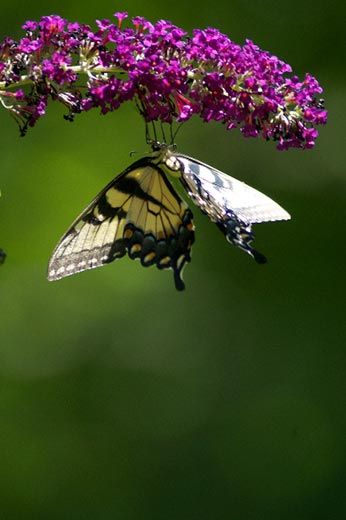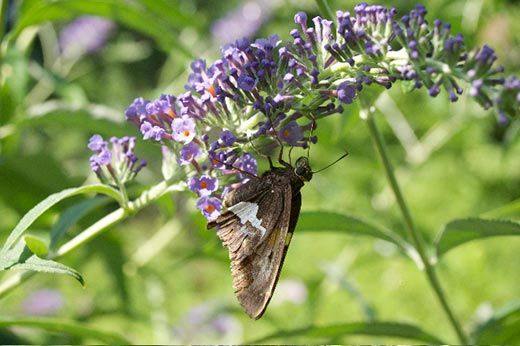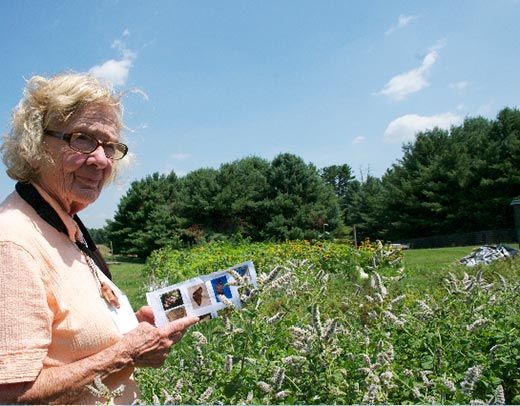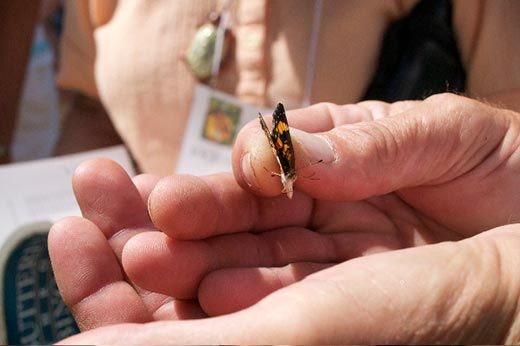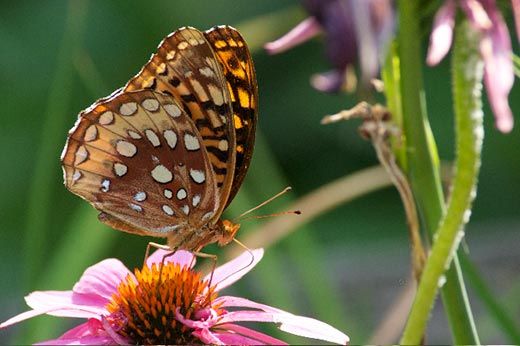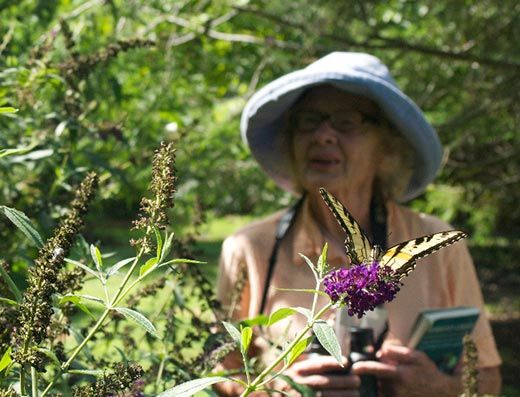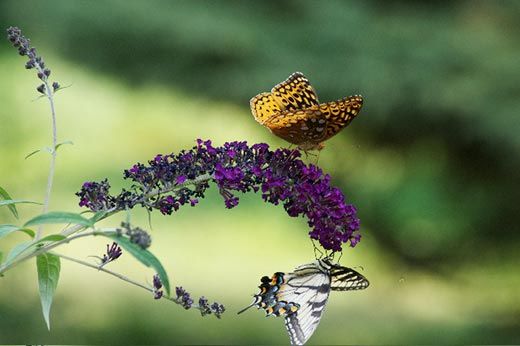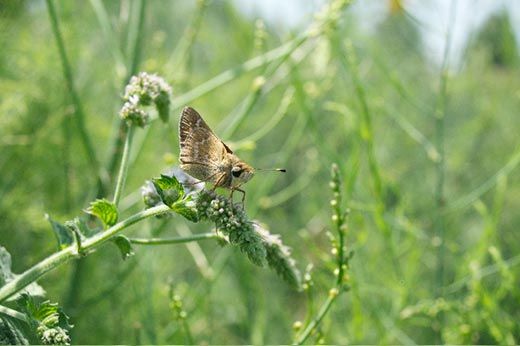Name That Butterfly
Citizen scientists on a sharp learning curve are carrying out an important census in fields and gardens across the country
/https://tf-cmsv2-smithsonianmag-media.s3.amazonaws.com/filer/silver-spotted-skipper-butterfly-631.jpg)
Counting butterflies is one of those things that sound easy but isn’t. Six of us are squinting and sweating in the morning sun, cameras and binoculars in hand, in the Peterson Butterfly Garden in Northern Virginia, and the butterflies are thick. Our goal today is to conduct a census of the butterflies in this garden and several neighboring fields.
In order to count a butterfly, we first have to identify it. Jocelyn Sladen, our group leader, points to the first butterfly of the day. “That is exactly the problem,” she says. “That little black butterfly could be one of any number of species.” What’s more, the trouble with counting butterflies in a butterfly garden is that there are a lot to count, and none of them hold still. Our little group moves through the garden together, one plant at a time, consulting our field guides whenever another butterfly species is discovered. While one volunteer questions a butterfly — “Oh, what are you?” — another cries “Come back, come back!” as a butterfly flits off, unidentified and uncounted.
In the midst of the chaos, there are successful identifications. “Now, that is a pearl crescent,” says Sladen. “Oh, good, good, good!” she says. We shout out more species names as that day goes on: Eastern tiger swallowtails, silver-spotted skippers, cabbage whites. A fritillary is spotted, to Sladen’s delight. And, only once, “That’s a monarch!”
We six are among the thousands of people who will take part in a North American Butterfly Association (NABA) butterfly count this year. Our count, which we share with several other groups of volunteers, encompasses a 15-mile-wide circle of fields, forests and gardens. The butterfly garden at the center of this circle is part of Airlie Center, a conference center and foundation in Northern Virginia. This year’s count is the 15th annual Airlie Butterfly Census. By sharing our results with NABA, we contribute to a continent-wide effort to track butterfly population trends over the years.
And the trends do not look good. Twenty-two species of butterflies in the United States are listed as endangered or threatened, and another 38 are considered candidates for listing, are species of concern or are currently under review, out of about 600 species in the lower 48 states. Butterflies, like bees, bats and hummingbirds, are important pollinators, and their numbers are declining. In 2007 the National Academy of Sciences issued a report called Status of Pollinators in North America that drew attention to a “demonstrably downward” trend in many wild pollinator populations, including some butterflies.
Scientists, gardeners and casual observers agree that our pollinators are in trouble. “When we were younger, we used to see so many more butterflies,” recalls Robin Williams, a volunteer in today’s census. But identifying a decline is not enough. To reverse downward trends, the causes of pollinator decline must be known. This may prove the greater challenge. As the National Academy of Sciences points out, “declines in many pollinator groups are associated with habitat loss, fragmentation, and deterioration, although in the United States data are, in most cases, inadequate to demonstrate causation unambiguously.”
As pollinator populations decline, interest in the butterfly count grows. NABA launched its butterfly count program in 1975. During that first year, only 29 counts were completed across the continent. By 2009, that number had grown to 463 individual counts — including the Airlie census — in the United States, Canada and Mexico. The vast majority of butterfly counters are citizen scientists—untrained volunteers who lend their eyes, ears and enthusiasm to ongoing scientific projects such as butterfly censuses or bird counts. Sladen speculates that there is a strong relationship between environmental decline and the rise of citizen scientists. “We are becoming so much more aware of what we are losing.” Still, Sladen wants to see more participation, especially from parents and children. “We need to get our children closer to nature.”
Counting butterflies could be a good way to reach this goal. Nearly 600 species of butterflies live in the lower 48 states, and dozens of these could be seen during our census. Proper identification requires sharp eyesight (a specialty of children) and patience to study detailed field guides. Every mark on the census sheet increases our knowledge about butterflies. Ultimately, this information may help scientists better understand the reasons behind pollinator decline and develop effective conservation solutions.
Of course, citizen science has its limitations. None of us are trained entomologists, and many butterflies are never identified. Others are surely misidentified. The differences between some species are subtle. For example, the Eastern tiger swallowtail, in its black phase, is nearly identical to the black swallowtail. Both are large black butterflies with blue accents and streamers on their wings. The only difference is a row of yellow spots running along the wings of the black swallowtail. The skippers are an even greater challenge. These little butterflies are plentiful and tiny—some are no larger than my thumb—and share similar markings across species. We see an agonizing variety of skippers. Mistakes are common. Perfection is not expected. “We are tremendously inaccurate,” admits Sladen, who has a simple piece of advice for volunteers: “Use your eyes and enjoy. Don’t worry about being wrong.”
Sladen’s advice is both kind and correct. These annual butterfly counts track population trends— evidence of more or fewer butterflies—not the actual number of all butterflies in a given census area. Because errors in counting and identification tend to hold fairly steady over the years, the census results can be trusted to illustrate these long-term population trends. By comparing census results across regions and years, NABA is able to follow changing trends in butterfly diversity and population numbers across North America.
By lunchtime, and the end of our census, we tallied 19 different species of butterflies and a total of 113 positively identified individuals (not including the countless unidentified butterflies). Our group’s totals will be combined with those of other census groups in the area and then submitted to the North American Butterfly Association.
The benefits here go beyond data. These annual butterfly censuses are open to volunteers of all ages and abilities — no prior butterfly counting experience is required. First-time participants may come simply to learn butterfly identification skills or enjoy a stroll in the summertime sun, but they go home as citizen scientists. Often, they return the next year as well. With any luck, they bring a friend or relative, eager to chase after butterflies for a summer morning.
“Once people do this, they tend to be hooked,” says Sladen. She appears to be right. After we’ve completed our census, first-time participant Janice Clarke leaves on this note: “I can’t wait to go home and do this in our gardens.”
